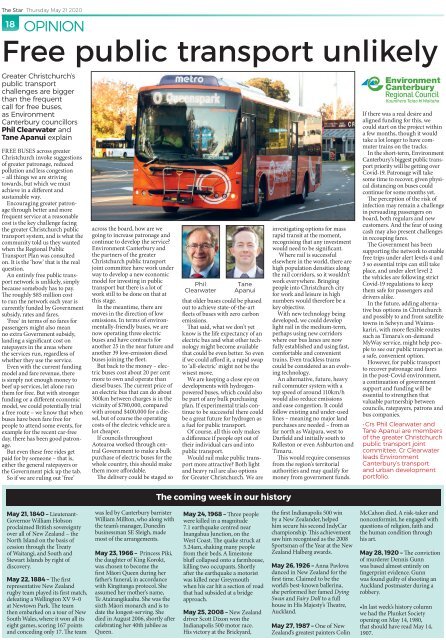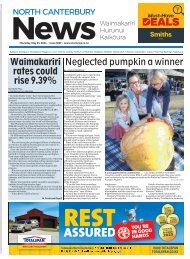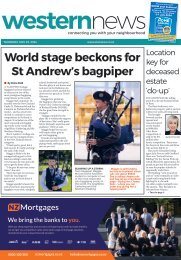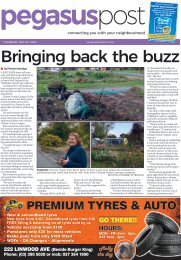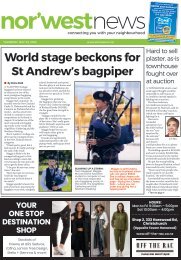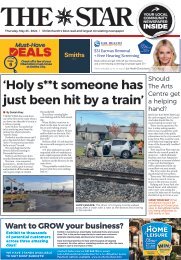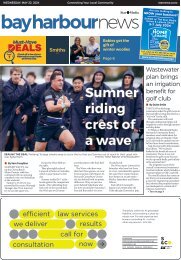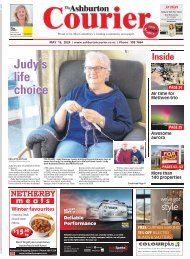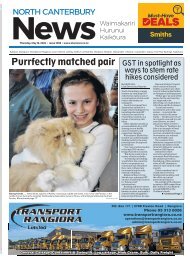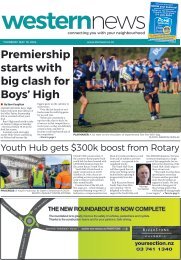The Star: May 21, 2020
You also want an ePaper? Increase the reach of your titles
YUMPU automatically turns print PDFs into web optimized ePapers that Google loves.
<strong>The</strong> <strong>Star</strong> Thursday <strong>May</strong> <strong>21</strong> <strong>2020</strong><br />
18<br />
OPINION<br />
Free public transport unlikely<br />
It’s a year since Environment Canterbury<br />
declared a climate-change emergency<br />
Greater Christchurch’s<br />
public transport<br />
challenges are bigger<br />
than the frequent<br />
call for free buses,<br />
as JENNY Environment<br />
HUGHEY explains what<br />
Canterbury the council has councillors<br />
been doing.<br />
Phil <strong>The</strong> Clearwater formal declaration and of a<br />
state of climate emergency across<br />
Tane Canterbury Apanui was one explain of the most<br />
serious, and colourful, moments<br />
FREE in the BUSES regional across council’s greater more than<br />
Christchurch 30-year history. invoke suggestions<br />
of greater A year patronage, ago this Saturday, reduced<br />
pollution at 11.49am, and Environment<br />
less congestion<br />
– all Canterbury things we became are striving New Zealand’s<br />
towards, first council but which to proclaim we must such an<br />
achieve emergency, in a different formally and dedicating<br />
sustainable itself to consideration way. of climate<br />
change Encouraging at the heart greater of all patronage<br />
through <strong>The</strong> declaration better and highlighted more<br />
it does.<br />
frequent that all the service work at Environment<br />
a reasonable<br />
cost Canterbury is the key does challenge – from facing<br />
the freshwater greater Christchurch management public to<br />
transport biodiversity system, and biosecurity, and is what the<br />
community transport and told urban us they development wanted<br />
when to air the quality, Regional and also Public regional<br />
Transport leadership Plan – has was a climate consulted change<br />
on. focus. It is the ‘how’ that is the real<br />
question.<br />
Currently, under the Resource<br />
Management<br />
An entirely free<br />
Act,<br />
public<br />
regional<br />
transport<br />
network is unlikely, simply<br />
councils are required only to adapt<br />
to climate change, not mitigate<br />
because<br />
it – that<br />
somebody<br />
responsibility<br />
has to<br />
is the<br />
pay.<br />
<strong>The</strong><br />
Government’s,<br />
roughly $85<br />
but<br />
million<br />
could<br />
cost<br />
change.<br />
to Even run the in ‘adapt network mode’ each many year is<br />
currently of Environment funded by Canterbury’s Government<br />
subsidy, existing rates policies and and fares. plans already<br />
contribute ‘Free’ in terms to reduced of no fares emissions. for<br />
passengers In declaring might the also climate mean<br />
no emergency, extra Government the Council subsidy, noted it<br />
landing would a continue significant to show cost leadership on<br />
ratepayers on climate-change in the areas and where do so<br />
the without services adding run, regardless new programmes of<br />
whether at ratepayers’ they use expense. the service. It also gave<br />
staff Even a with clear the mandate current to funding continue<br />
model and fare revenue, there<br />
is simply not enough money to<br />
beef up services, let alone run<br />
them for free. But with stronger<br />
funding or a different economic<br />
model, we could potentially trial<br />
a free route – we know that when<br />
buses have been fare free for<br />
people to attend some events, for<br />
example for the recent car-free<br />
day, there has been good patronage.<br />
But even these free rides get<br />
paid for by someone – that is,<br />
either the general ratepayers or<br />
the Government pick up the tab.<br />
So if we are ruling out ‘free’<br />
and enhance that work.<br />
That work included setting<br />
up a climate-change integration<br />
programme in the Long-term Plan<br />
2018-28, ensuring climate change<br />
was actively considered across<br />
workstreams, increasing visibility<br />
of the science and what we know<br />
about the impact of climate<br />
change on Canterbury, and liaising<br />
on the issue with iwi and regional<br />
across<br />
partners,<br />
the board,<br />
other local<br />
how<br />
authorities<br />
are we<br />
going<br />
and central<br />
to increase<br />
government.<br />
patronage and<br />
continue<br />
As an<br />
to<br />
organisation,<br />
develop the<br />
we<br />
service?<br />
have<br />
Environment<br />
also made significant<br />
Canterbury<br />
progress<br />
and<br />
in<br />
the addressing partners our of the own greater greenhousegas<br />
emissions, public with our transport<br />
Christchurch<br />
joint Christchurch committee building have work receiving under a<br />
way “market-leading” to develop a new energy economic efficiency<br />
model rating for of 5.0 investing out of 6 in in public the year<br />
transport to February but on there is National a lot of<br />
work Australian still to Built be done Environment<br />
that at<br />
this Rating stage. System New Zealand.<br />
In <strong>The</strong> the building’s meantime, features there include are<br />
moves 184 solar in the panels direction which of can low<br />
emissions. generate more In terms than of 55,000 environmentally-friendly<br />
kilowatt hours of buses, electricity we are per<br />
now year. operating three electric<br />
buses <strong>The</strong>re and has have been contracts a 26% reduction for<br />
another per staff 25 member in the near in emissions future and<br />
another since 3039 June low-emission 2010. We now diesel have<br />
buses access joining to electric the fleet. and hybrid<br />
vehicles But back and to hope the money to have – half elec-outric<br />
buses cost about 20 per cent<br />
more to own and operate than<br />
diesel buses. <strong>The</strong> current price of<br />
an electric bus that can do about<br />
300km between charges is in the<br />
vicinity of $780,000, compared<br />
with around $400,000 for a diesel,<br />
but of course the operating<br />
costs of the electric vehicle are a<br />
lot cheaper.<br />
If councils throughout<br />
Aotearoa worked through central<br />
Government to make a bulk<br />
purchase of electric buses for the<br />
whole country, this should make<br />
them more affordable.<br />
<strong>The</strong> delivery could be staged so<br />
Environment<br />
Canterbury Chair<br />
Jenny Hughey<br />
fleet hybrid or long-range electric<br />
by 2022. Carbon emissions from<br />
air travel across the organisation<br />
are offset via our own biodiversity<br />
programmes.<br />
According to a Madworld report<br />
in 2019, our gross emissions were<br />
2253 tonnes of carbon dioxide<br />
(CO2) equivalent, compared with<br />
removals of 7883 tonnes of CO2-<br />
equivalent through our efficiency<br />
efforts and from forestry planting<br />
across 2700 hectares.<br />
<strong>The</strong> changing climate will pose<br />
many risks to life and livelihood<br />
in Canterbury. In recent years<br />
we have seen how occasional,<br />
but extreme, weather events have<br />
had huge effects on residents and<br />
infrastructure Phil around the Tane South<br />
Island. Clearwater Apanui<br />
<strong>The</strong> driest parts of our region,<br />
that along older the buses Marlborough could be coast phased and<br />
out across to achieve much of state-of-the-art<br />
the Canterbury<br />
fleets Plains, of are buses expected with zero to get carbon even<br />
emissions. drier. North-westerly storms are<br />
predicted That said, to what become we don’t more yet intense,<br />
know with torrential is the life alpine expectancy rainstorms of an<br />
electric turning bus our and braided what rivers other into technology<br />
roaring might rapids, become fuelling available landslides<br />
that and could causing be widespread even better. erosion. So even<br />
if we Canterbury’s could afford coastal it, a rapid swap<br />
to communities ‘all-electric’ will might be threatened not be the<br />
wisest move.<br />
We are keeping a close eye on<br />
developments with hydrogenpowered<br />
buses, which could also<br />
be part of any bulk purchasing<br />
plan. If experimental trials continue<br />
to be successful there could<br />
be a great future for hydrogen as<br />
a fuel for public transport.<br />
Of course, all this only makes<br />
a difference if people opt out of<br />
their individual cars and into<br />
public transport.<br />
Would rail make public transport<br />
more attractive? Both light<br />
and heavy rail are also options<br />
for Greater Christchurch. We are<br />
by sea-level rise this century and<br />
our productive and protected land<br />
jeopardised by the arrival and<br />
spread of new, exotic weeds and<br />
pests from warmer climates.<br />
All these eventualities have<br />
to be planned and prepared for,<br />
and Environment Canterbury<br />
will remain in the vanguard of<br />
these climate change efforts.<br />
One example is the $40 million<br />
Waimakariri River flood<br />
protection project, completed<br />
late last year. <strong>The</strong> network of<br />
floodgates and stopbanks will<br />
protect half a million people and<br />
$8 billion of community and<br />
business assets from a possible<br />
investigating “super flood”. options for mass<br />
rapid <strong>The</strong> transit last major at the flood moment, was in<br />
recognising December 1957, that any when investment parts<br />
would of Coutts need Island to be in significant. Belfast and<br />
Kainga Where were rail swamped is successful by river<br />
elsewhere flow peaking the at 3990 world, cubic there are<br />
high<br />
metres<br />
population<br />
per second<br />
densities<br />
(cumecs).<br />
along<br />
the<br />
<strong>The</strong><br />
rail<br />
protection<br />
corridors,<br />
scheme<br />
so it wouldn’t<br />
has been<br />
designed to defend Christchurch<br />
work everywhere. Bringing<br />
from a flood of as much as 6500<br />
people into Christchurch city<br />
cumecs.<br />
for<br />
Environment<br />
work and leisure<br />
Canterbury’s<br />
in high<br />
numbers<br />
leadership<br />
would<br />
of biodiversity<br />
therefore<br />
and<br />
be a<br />
key biosecurity objective. programmes is also<br />
underpinned With new technology by climate-change being<br />
developed, concerns. we could develop<br />
light Canterbury’s rail in the distinct medium-term, braided<br />
perhaps rivers and using unique new wetlands corridors face<br />
where many challenges. our bus lanes <strong>The</strong> are rivers now form<br />
fully a vital established ecological and link using and provide fast,<br />
comfortable an abundant and food convenient supply and<br />
trains. nesting Even grounds trackless for 26 trams species of<br />
could native be birds considered – most classified an evolving<br />
technology.<br />
as<br />
An alternative, future, heavy<br />
rail commuter system with a<br />
top speed of around 110km/h<br />
would also reduce emissions<br />
and ease congestion. It could<br />
follow existing and under-used<br />
lines – meaning no major land<br />
purchases are needed – from as<br />
far north as Waipara, west to<br />
Darfield and initially south to<br />
Rolleston or even Ashburton and<br />
Timaru.<br />
This would require consensus<br />
from the region’s territorial<br />
authorities and may qualify for<br />
money from government funds.<br />
If threatened there was and a real facing desire increased and<br />
aligned pressures funding due to river for this, system we<br />
could change. start on the project within<br />
a few Wetlands months, are though also ecosystems it would<br />
take at-risk a lot nationally longer to and have regionally, commuter<br />
degraded trains by draining, on the tracks. damming<br />
and In diversion the short-term, affecting Environment their<br />
Canterbury’s ability to sequester biggest carbon, public transport<br />
cleanse priority freshwater will be and getting mitigate over<br />
Covid-19. flooding, as Patronage well as impacting will take on<br />
some biodiversity time to and recover, mahinga given kai. physical<br />
With<br />
distancing<br />
biosecurity,<br />
on buses<br />
we are<br />
could<br />
continue<br />
putting greater<br />
for some<br />
emphasis<br />
months<br />
on<br />
yet.<br />
the<br />
risks of new pests establishing<br />
<strong>The</strong> perception of the risk of<br />
in Canterbury. Warming<br />
infection may remain a challenge<br />
temperatures, changing soils and<br />
in<br />
new<br />
persuading<br />
land uses mean<br />
passengers<br />
new weeds<br />
on<br />
board,<br />
especially,<br />
both<br />
will<br />
regulars<br />
be able<br />
and<br />
to gain<br />
new<br />
a<br />
customers. better foothold And across the fear the of region. using<br />
cash More may broadly, also present we have challenges to<br />
in curb recouping reliance on fares. fossil fuels and<br />
find <strong>The</strong> environmentally Government has suitable been<br />
supporting alternatives, the such network as electricity to enable and<br />
free hydrogen, trips under to power alert our levels public 4 and<br />
3 transport. so essential trips can still take<br />
place, When and my under predecessor alert level Steve 2<br />
the Lowndes vehicles retired are following as chair of strict<br />
Covid-19 this council regulations late last year, to keep he<br />
them highlighted safe for some passengers of the big and<br />
drivers changes alike. on the way. He was<br />
optimistic In the future, we would adding be able alternative<br />
deal bus with options the “pressing Christchurch issues” of<br />
to<br />
and climate possibly change to and sustainability.<br />
from satellite<br />
towns I share in his Selwyn confidence. and Waimakariri,<br />
community, with more and as flexible a council, routes<br />
As a<br />
such we are as taking Timaru’s some on-demand bold steps to<br />
MyWay ensure we service, are in a might better help place people<br />
cope to with see our the changing public transport climate as<br />
to<br />
a and safe, the convenient tests it will option. set us. But<br />
there However, will always for public be a need transport to do<br />
to more. recover patronage and fares<br />
in the post-Covid environment,<br />
a continuation of government<br />
support and funding will be<br />
essential to strengthen that<br />
valuable partnership between<br />
councils, ratepayers, patrons and<br />
bus companies.<br />
• Crs Phil Clearwater and<br />
Tane Apanui are members<br />
of the greater Christchurch<br />
public transport joint<br />
committee. Cr Clearwater<br />
leads Environment<br />
Canterbury’s transport<br />
and urban development<br />
portfolio.<br />
<strong>The</strong> coming week in our history<br />
<strong>May</strong> <strong>21</strong>, 1840 – Lieutenant-<br />
Governor William Hobson<br />
proclaimed British sovereignty<br />
over all of New Zealand – the<br />
North Island on the basis of<br />
cession through the Treaty<br />
of Waitangi, and South and<br />
Stewart Islands by right of<br />
discovery.<br />
<strong>May</strong> 22, 1884 – <strong>The</strong> first<br />
representative New Zealand<br />
rugby team played its first match,<br />
defeating a Wellington XV 9–0<br />
at Newtown Park. <strong>The</strong> team<br />
then embarked on a tour of New<br />
South Wales, where it won all its<br />
eight games, scoring 167 points<br />
and conceding only 17. <strong>The</strong> team<br />
was led by Canterbury barrister<br />
William Millton, who along with<br />
the team’s manager, Dunedin<br />
businessman SE Sleigh, made<br />
most of the arrangements.<br />
<strong>May</strong> 23, 1966 – Princess Piki,<br />
the daughter of King Korokī,<br />
was chosen to become the<br />
first Māori Queen during her<br />
father’s funeral, in accordance<br />
with Kīngitanga protocol. She<br />
assumed her mother’s name,<br />
Te Atairangikaahu. She was the<br />
sixth Māori monarch and is to<br />
date the longest-serving. She<br />
died in August 2006, shortly after<br />
celebrating her 40th jubilee as<br />
Queen.<br />
<strong>May</strong> 24, 1968 – Three people<br />
were killed in a magnitude<br />
7.1 earthquake centred near<br />
Inangahua Junction, on the<br />
West Coast. <strong>The</strong> quake struck at<br />
5.24am, shaking many people<br />
from their beds. A limestone<br />
bluff collapsed onto a farmhouse,<br />
killing two occupants. Shortly<br />
after the earthquake a motorist<br />
was killed near Greymouth<br />
when his car hit a section of road<br />
that had subsided at a bridge<br />
approach.<br />
<strong>May</strong> 25, 2008 – New Zealand<br />
driver Scott Dixon won the<br />
Indianapolis 500 motor race.<br />
His victory at the Brickyard,<br />
the first Indianapolis 500 win<br />
by a New Zealander, helped<br />
him secure his second IndyCar<br />
championship. This achievement<br />
saw him recognised as the 2008<br />
Sportsman of the Year at the New<br />
Zealand Halberg awards.<br />
<strong>May</strong> 26, 1926 – Anna Pavlova<br />
danced in New Zealand for the<br />
first time. Claimed to be the<br />
world’s best-known ballerina,<br />
she performed her famed Dying<br />
Swan and Fairy Doll to a full<br />
house in His Majesty’s <strong>The</strong>atre,<br />
Auckland.<br />
<strong>May</strong> 27, 1987 – One of New<br />
Zealand’s greatest painters Colin<br />
McCahon died. A risk-taker and<br />
nonconformist, he engaged with<br />
questions of religion, faith and<br />
the human condition through<br />
his art.<br />
<strong>May</strong> 28, 1920 – <strong>The</strong> conviction<br />
of murderer Dennis Gunn<br />
was based almost entirely on<br />
fingerprint evidence. Gunn<br />
was found guilty of shooting an<br />
Auckland postmaster during a<br />
robbery.<br />
•In last week’s history column<br />
we had the Plunket Society<br />
opening on <strong>May</strong> 14, 1980,<br />
that should have read <strong>May</strong> 14,<br />
1907.


